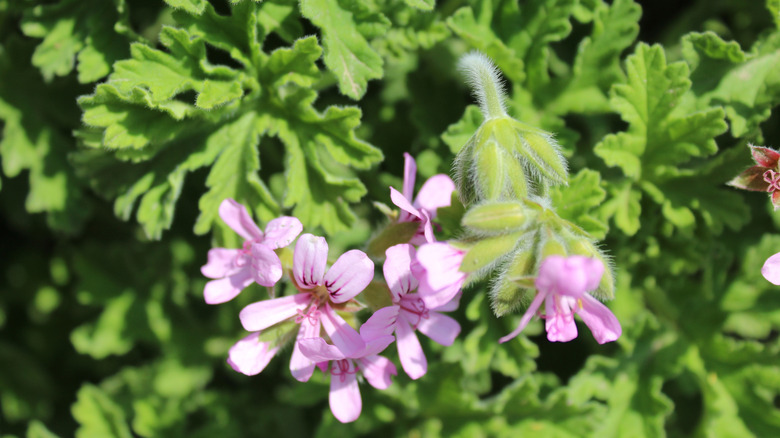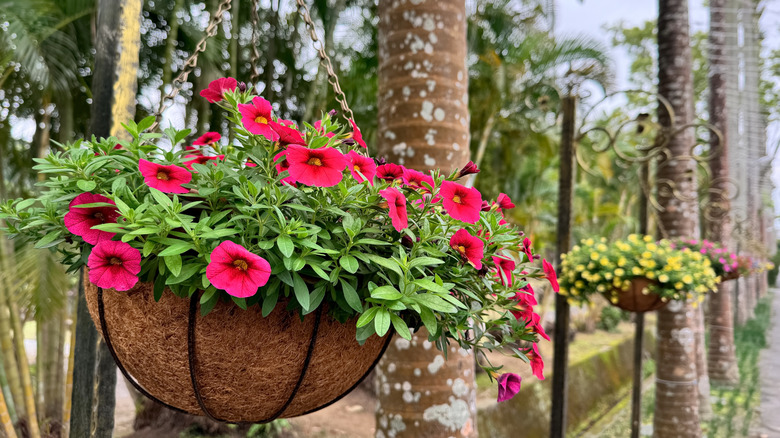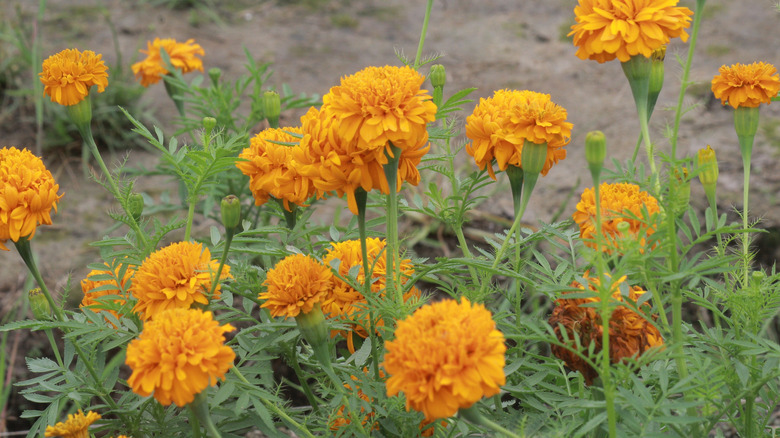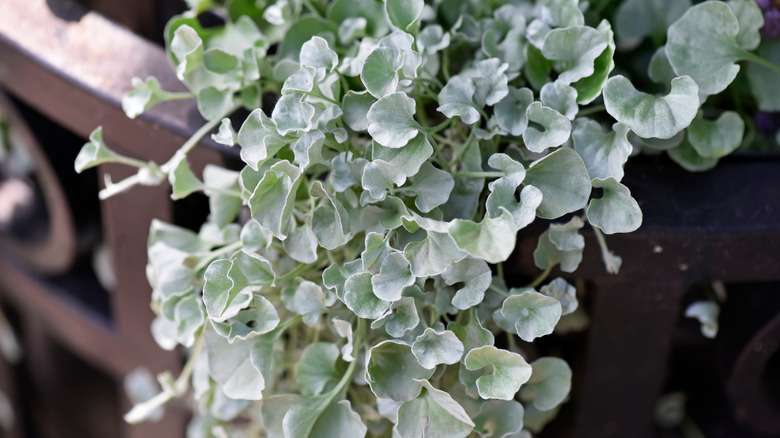Scented Geraniums Thrive With These Easy-Growing Companions
What do lemon, mint chocolate, apple, and coconut have in common? They're all fragrances that naturally appear in scented geraniums, plants with aromatic oils in the base of their leaves. Scented geraniums come in a stunning array of aromas, from pine to rose and beyond. These scents aren't just appealing to people — they also help repel pests, which is part of why scented geraniums are a popular companion for other low-maintenance plants.
Scented geraniums are not true geraniums, but members of the Pelargonium genus. Pelargoniums are often referred to as geraniums thanks to their similar appearance and a centuries-old naming mishap that has stuck over the years. But although the two look somewhat alike, pelargoniums and geraniums are two different genera. Unlike perennial geraniums, scented geraniums are grown as annuals in most parts of the U.S. and are only cold hardy in USDA zones 10 and 11. And while most geraniums are grown primarily for their beautiful flowers, scented geraniums are more famous for the lovely fragrances that their leaves emit when touched or crushed (though the flowers are also quite pretty). Each species has a different scent and can be grown either as a houseplant, outdoor container plant, or in a garden bed.
Scented geraniums are prime candidates for companion planting, and not just because of their pest-repelling abilities. They're low-maintenance plants that don't require frequent watering or fertilizing, so they can thrive alongside a range of other plants. Three plants that work especially well as companions for scented geraniums are calibrachoa, marigolds, and dichondra.
Growing scented geraniums with calibrachoa
A common tactic for companion planting in containers is the "thriller, filler, and spiller" technique, in which plants with different growth habits are combined to create an aesthetically balanced design. Calibrachoa and scented geranium are a great example. Calibrachoa is low growing with bright, vibrant flowers, which would work particularly well with a taller, upright variety of scented geranium. Calibrachoa happens to be well-suited to containers, and this combination is perfect for hanging baskets. There are many colors and varieties of calibrachoa to choose from, including the popular Million Bells flowers, which leave room for creativity in designing your garden. Both scented geranium and calibrachoa will bloom all summer long. Place them near walkways to enjoy a burst of scent each time you brush past the scented geraniums' leaves.
These two also make good companion plants because they have similar care requirements. Calibrachoa and scented geranium are both annuals that require full sun, and both should be planted in spring after the last frost. Plant your scented geranium and calibrachoa in a well-draining potting mix with about 12 inches between each plant. Water thoroughly when the top of the soil is dry. One thing to keep in mind is that calibrachoas are heavier feeders than scented geraniums; to avoid under-feeding or over-feeding either plant, you can strike the balance by fertilizing about every two and a half weeks during the growing season.
Growing scented geraniums with marigolds
Like scented geraniums, marigolds are commonly planted because they have the ability to ward off troublesome pests. Scented geraniums repel cabbage worms, beetles, and mosquitoes, and marigolds drive away nematodes and aphids while attracting beneficial insects like ladybugs and bees. These plants are like two peas in a pod for other reasons too: They're both easy to grow and require full sun and well-draining soil, with comparable watering needs. They're both typically grown as annuals and thrive in containers as well as garden beds.
Visually, this combination has a lot to offer. Marigolds feature striking golden or red flowers, which scented geraniums contrast with their delicate green foliage and smaller, typically white or pink flowers. A sprawling variety of scented geranium could work well to contrast the upright-growing marigolds. Marigolds will also keep your garden interesting throughout much of the year, blooming from spring all the way until the first frost of the fall or winter. Meanwhile, scented geraniums tend to bloom in the summer.
You can either start marigolds from seed a few weeks before the last frost of the spring or purchase plants from a gardening store. Place each plant about 10 inches apart. Marigolds are light feeders just like scented geraniums; you can even use compost to add nutrients as needed instead of fertilizer. To encourage the marigolds to stay in bloom for longer, water at least weekly and prune early flower buds as well as spent flowers.
Growing scented geraniums with dichondra
Want your scented geraniums to be the star of the show? Choose dichondra as a companion. With its trailing growth habit and pretty foliage, this plant provides a nice contrast to upright or compact varieties of scented geranium. For example, the 'Silver Falls' cultivar of dichondra has silver-green leaves that would beautifully complement a pink-flowered variety of scented geranium. Dichondra only blooms in early summer, and the flowers are not very noticeable. It works well as a cascading plant in hanging baskets or as a trailing ground cover. Though dichondra can grow in partial shade, scented geranium grows best in full sun, so it's best to choose a bright spot for this pair. Both require well-draining soil.
Dichondra makes a gorgeous no-mow lawn and is often used as an annual, though it is hardy in zones 8 to 10. It's low-maintenance and a quick grower, so much so that it's considered a weed in some areas. However, it can be trimmed or mowed to maintain a neat look. If growing from seed, start dichondra indoors 12 weeks before the last frost; alternatively, you can purchase plants from a nursery or gardening store. Like scented geranium, dichondra doesn't need much fertilizer. Compost works well, or you can add a slow-release fertilizer at the beginning of the growing season to keep both plants happy. When grown in containers, they will need more frequent watering, but both plants are fairly drought-resistant.



